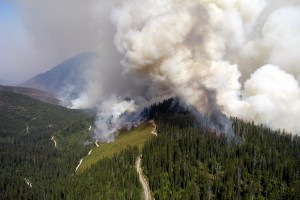Voltaire once wrote that “men argue; nature acts.” We see that action repeatedly in catastrophic forest fires across the western United States, and each time we hope it may be the last. This week we’re seeing yet another forest go up in smoke – Glacier National Park in Montana – while land managers, politicians, lobbyists, and environmentalists argue.
 This fire has now burned over 6 square miles of beautiful forests, once considered among America’s finest, yet among the news stories a crucial fact is rarely mentioned: these fires are not natural. They are caused by mismanagement of the forests. In fact, our generation has all but stopped the professional management of our public forests, and we are witnessing the disease, death, rotting, collapse, and burning of billions of trees covering millions of acres of previously healthy forest lands. Some of these devastated landscapes will not recover their former beauty in our lifetimes, and some will never again provide the same habitat for wildlife, or the same quality water supply they once did.
This fire has now burned over 6 square miles of beautiful forests, once considered among America’s finest, yet among the news stories a crucial fact is rarely mentioned: these fires are not natural. They are caused by mismanagement of the forests. In fact, our generation has all but stopped the professional management of our public forests, and we are witnessing the disease, death, rotting, collapse, and burning of billions of trees covering millions of acres of previously healthy forest lands. Some of these devastated landscapes will not recover their former beauty in our lifetimes, and some will never again provide the same habitat for wildlife, or the same quality water supply they once did.
For centuries North American forests enjoyed a state of natural balance, which is easily upset when people and cities move in. So our job as good stewards is to mimic the role of nature as closely as possible, to maintain the most “natural” conditions possible. We have failed miserably. In a nutshell, here is what has happened:
• Nature had always kept the growth of forests in check with periodic fires, sparked by lightning. Natural fires burn the brush and grasses, also destroying saplings and small trees so the forest does not grow too dense, but mostly leaving older and larger trees undamaged.
• After Americans began to settle the West, depending on forests for needed wood, they viewed forest fires as a crisis. They spent vast resources putting out fires, a primary goal of forest management for over a century.
• Despite that activity, national forests still were not overly dense because the natural role of fire was replaced with a steady program of forest thinning. National forests were logged to provide lumber, recreation, healthy watersheds, species protection, and to prevent fires.
• Then in the late 20th Century, logging became unpopular. Timber sales were mostly eliminated in national forests, and completely in national parks. Logging on federal land plummeted by an incredible 84% since the 1980s. And we replaced that management tool with – nothing.
The result is a massive unnatural overgrowth – a tinderbox that, when ignited, obliterates the landscape. Politicians react with money, committees, planning, studies, and meetings. And while American political leaders argue about forest management, nature is running the only other course possible.
All plants either grow or die. We all care about preserving forests, but some misguided activists think we can stop all activity in our national forests, and keep them forever in the same condition, like preserving a snapshot for all time. They could not be more wrong. Leaving the forests alone – neglecting them – is a death sentence. Forests are not static snapshots; the trees keep growing. Our national forests produce eight times more new growth than managers remove every year. If the amount grown and the amount removed are not similar, no snapshot can be maintained; instead, the situation will worsen every year. That is exactly what is happening across vast landscapes of the American West, where wildfires have ravaged 70 million acres of our prized forests in the last ten years.
In response, we spend billions on fire suppression and “fuel load” removal required by the death and decay of our forests. It would be far more efficient to treat the forests (thin the overload and restore healthy trees) than to put out fires and deal with the dead landscapes left in their wake.
Because trees live, grow, and die, forests cannot be preserved in their current condition forever. So we face a clear and simple choice that is never presented to the public. Forests must be thinned, or allowed to die, rot, or burn. Do we want logging, or do we want catastrophic forest fires?
An ancient philosopher once wrote that forests precede civilizations, and deserts follow. That does not have to be true today. We know how to manage forests to sustain their yield and their beauty forever. We are failing miserably, and we must get our act together while there are still great forests like Glacier National Park to be preserved and protected.
(A version of this column originally appeared in the Grand Junction Daily Sentinel July 24, 2015)




Comments on this entry are closed.